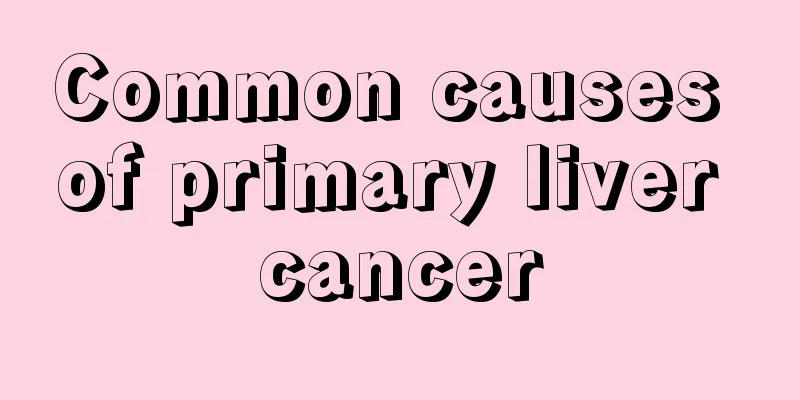Common causes of primary liver cancer

|
The cause of primary liver cancer has not yet been determined. It is generally believed to be related to the combined effects of multiple factors. 1. Viral hepatitis and cirrhosis Through the study of the relationship between hepatitis B virus and liver cancer, it was found that: ① more than 90% of liver cancer patients had positive hepatitis B markers in their serum (only about 15% in the control group); ② HBsAg-positive people in high-incidence areas of liver cancer have a 6-50 times higher chance of developing liver cancer than those with negative results; ③ molecular biological studies have shown that simple integrated HBV-DNA accounts for 151.5% of liver cancer patients in my country; ④ HBV's X gene can change the gene expression of HBV-infected liver cells, which may be related to carcinogenesis. The above shows that hepatitis B virus is closely related to liver cancer and is an important risk factor for liver cancer. In recent years, the relationship between hepatitis C and liver cancer has attracted attention. Data from my country show that 5%-8% of patients with hepatocellular carcinoma are anti-HCV positive, while the control group is 0%-2%. In liver cancer cases, there are many patients with anti-HCV and HBV co-infection. The relationship between HCV and liver cancer is extremely important in Japan, but it remains to be confirmed in China. (ii) Aflatoxin Surveys in areas with a high incidence of liver cancer, especially in the southern regions where corn is the main staple food, show that the prevalence of liver cancer may be related to the contamination of grain by aflatoxin Bi, and that the level of aflatoxin Mi, a metabolite of aflatoxin Bi, in human urine is very high. Aflatoxin Bi is the strongest carcinogen for animal liver cancer, but there is no direct evidence of its relationship with human liver cancer. 3. Drinking water pollution In Qidong, Jiangsu, the incidence of liver cancer among people who drink ditch water is (60-101)/1.1 million, and that among those who drink well water is (0-19)/100,000. The relative risk of people who drink ditch water is 3.00. The investigation found that there is a kind of blue-green algae in ditch water that produces algae toxins, which may contaminate drinking water and cause liver cancer. 4. Genetic factors In high-incidence areas, liver cancer sometimes clusters in families, especially among people who live together and have blood ties. This may be related to vertical transmission of the hepatitis virus, but this remains to be confirmed. (V) Others Other suspected carcinogens or carcinogenic factors that may cause liver cancer include: 1. Ethanol poisoning. 2. Nitrosamines. 3. Pesticides such as organochlorine, etc. 4. Trace elements: In areas where liver cancer is prevalent, water, soil, food, human hair and blood contain high levels of copper and zinc, and low levels of molybdenum. 5. Clonorchis sinensis, which can stimulate the proliferation of bile duct epithelium and produce cholangiocarcinoma. 6. Trace elements, sex hormones, radioactive substances, parasites, alcoholism, smoking, genetic factors, etc. |
<<: Commonly used prescriptions for esophageal cancer
>>: Dissemination and metastasis of renal cancer
Recommend
What principles should bone cancer patients generally pay attention to in their diet
The dietary methods and habits of bone cancer pat...
Can Chinese medicine cure my liver cancer?
Other conventional treatments are recommended for...
Swollen eyelids and red bloodshot eyes
The phenomenon of swollen eyelids and red bloodsh...
What to eat to prevent liver cancer? Experts recommend eating these often
Prevention of liver cancer starts with daily diet...
What are the steps for washing white clothes with white vinegar?
I believe that many people have white clothes in ...
The navel is red, swollen and leaking water
Although the belly button is very small, it is al...
How to remove glue from cups?
Whether in industry or in family life, people nee...
My teeth hurt when I run
Running is an exercise that many people like. It ...
What kind of physique is not suitable for swimming?
Only by exercising continuously can the human bod...
How to eat ginkgo nuts without getting poisoned
As the name suggests, ginkgo fruit is the fruit o...
What factors are related to the life expectancy of bone cancer
What factors affect the life expectancy of bone c...
What are the hazards of methanol to human body
Formaldehyde is a harmful substance and it is als...
Where do bone tumors usually grow?
Tumor is a relatively common disease, and bone tu...
How can men stay away from the dangers of prostate cancer
Prostate cancer is a huge bad news for every man....
How to treat hamartoma in a good hospital
How is the best hospital to treat hamartoma? Ther...









